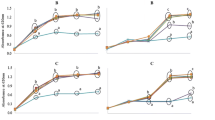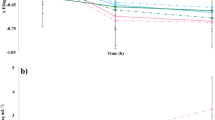Summary
Background
Only a small part of the dietary anthocyanins are absorbed. Thus large amounts of the ingested compounds are likely to enter the colon. In vitro and in vivo studies have shown that colonic bacteria transform various flavonoids to smaller phenolic acids. However, there is very little information on bacterial transformations of anthocyanins.
Aim of the study
was to explore if anthocyanin glycosides were deglycosylated,whether the resulting aglycones were degraded further to smaller phenolic compounds by colonic bacteria, and to characterise metabolites.
Methods
Isolated cyanidin–3–glucoside and –rutinoside were fermented in vitro using human faecal microbiota as an inoculum. Metabolites were analysed and characterised by HPLC–DAS and LC–MS. They were identified by comparing their characteristics with those of available standards, and semi–quantified using the amount of substrate analysed from samples at initial timepoint.
Results
Cyanidin–3–glucoside and cyanidin aglycone could be identified as intermediary metabolites of cyanidin–3–rutinoside. At early timepoints (before 2 h), the formation of protocatechuic acid as a major metabolite for both cyanidin glycosides and detection of lower molecular weight metabolites show that anthocyanins were converted by gut microflora. Furthermore, reconjugation of the aglycone with other groups, non–typical for dietary anthocyanins, was evident at the later (after 2h) timepoints.
Conclusion
Bacterial metabolism of anthocyanins involves the cleavage of glycosidic linkages and breakdown of the anthocyanidin heterocycle.
Similar content being viewed by others

Abbreviations
- Cy3g:
-
cyanidin–3–glucoside
- Cyrut:
-
cyanidin–3–rutinoside, cyanidin–3–rhamnoglucoside
- Cy-1:
-
bacterial metabolite from cyanidin glycosides: aglycone, cyanidin.
- Cy-2:
-
bacterial breakdown product from cyanidin glycosides: protocatechuic acid (3,4–dihydroxybenzoic acid)
- Cy-3:
-
unidentified bacterial metabolite from cyanidin glycosides
- Cy-4:
-
bacterial conjugate of cyanidin possibly containing nitrogen or sulphur
- HPLC-DAS:
-
high–performance liquid chromatography–photodiode array spectrometry
Author information
Authors and Affiliations
Corresponding author
Rights and permissions
About this article
Cite this article
Aura, AM., Martin-Lopez, P., O’Leary, K.A. et al. In vitro metabolism of anthocyanins by human gut microflora. Eur J Nutr 44, 133–142 (2005). https://doi.org/10.1007/s00394-004-0502-2
Received:
Accepted:
Published:
Issue Date:
DOI: https://doi.org/10.1007/s00394-004-0502-2



